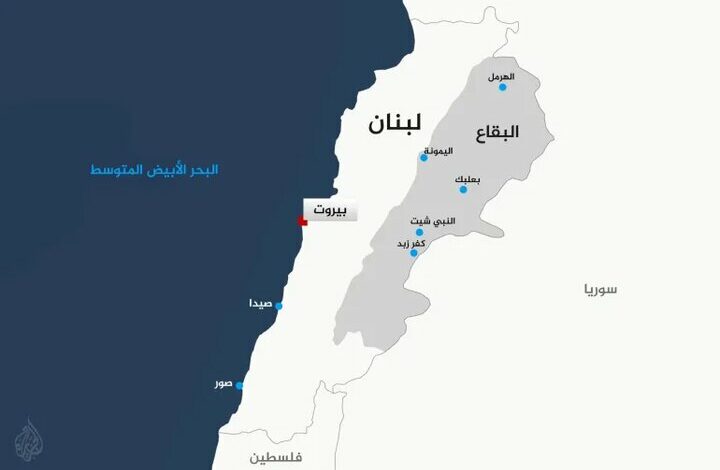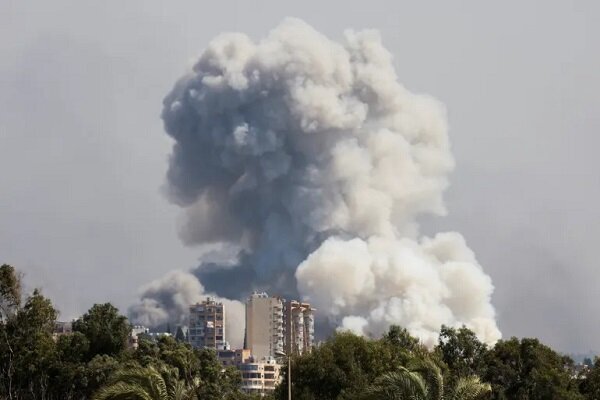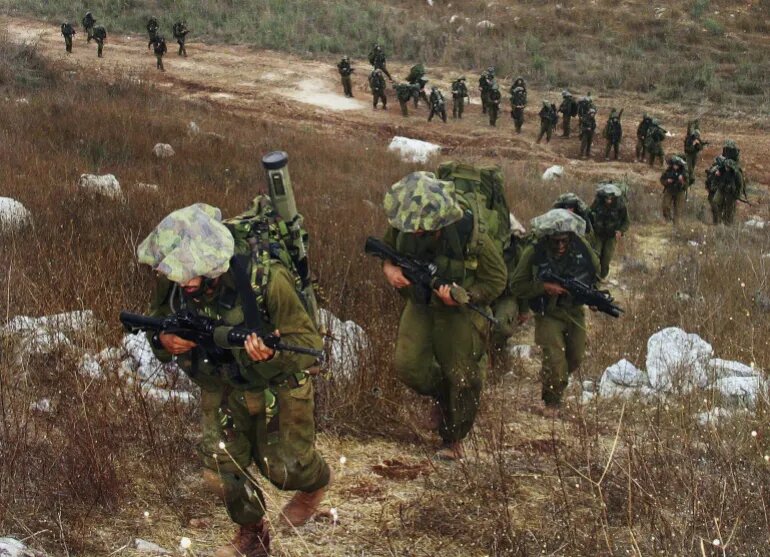Has the third war in Lebanon started? / The coordinates of the new war and the scope of its development

report Mehr News Agency quoted from Al Jazeera, while on Wednesday, September 18, we witnessed successive explosions of pagers in Lebanon, YOF Gallant, the Israeli Minister of War, from Ramat David Air Base, the largest base in the North He visited the occupied territories and one of the three main air bases of this regime and announced that “the center of gravity of our operations is moving to the north”, and described this move as the beginning of a “new phase of war”.
The next day, September 19, the Zionist regime carried out its heaviest airstrikes on Lebanon since the start of the Gaza war about a year ago. Lebanese sources told Reuters that these attacks may be the most severe attacks in recent years.
The strikes of the Zionist regime, the villages of southern Lebanon, including Adshit Al Qusayr, Qbarikha, Bani Hayan, span style=”text-align:justify”>Merkaba, Rab Talasin, Majdal and It targeted Mehruneh, where hundreds of thousands of people live. Also, the warplanes of this regime flew over Beirut, the capital of Lebanon, and by crossing the sound wall in a demonstration attack, they tried to create panic among the capital’s residents.
Another possible goal of the Zionist attacks is to force Hezbollah to separate the Lebanese front from the Gaza front, because Hezbollah has linked the cessation of its attacks to a ceasefire in Gaza. Considering the strong connection between these two fronts since the beginning of the war and the heavy political and military costs for any withdrawal, it seems difficult to achieve this goal. The stoppage continued and on Sunday and Monday, September 22 and 23, these attacks became more intense and widespread. The Israeli army also announced that its fighters bombed about 1,300 Hezbollah targets in southern and eastern Lebanon. These aggressive actions were consistent with the statements of the Zionist commanders and the movements of the army of this regime towards the Lebanese front, which have intensified in the last two weeks.
Even before the explosion of pager and communication devices, the Zionist Army, the 98th Brigade which included about 10,000 to 20,000 commandos and paratroopers, sent north to join the 36th Armored Brigade; This brigade was previously transferred from the Gaza Strip to the north.
In addition to these units, the 91st Brigade, which is responsible for protecting the borders of the occupied territories with Lebanon, was on standby along with the reserve forces of these units.
Meanwhile, Avery Godin, the commander of the Northern Front of the Zionist regime, visited the exercises of reserve soldiers of the 179th brigade, and before that other exercises for the 769th brigade (Hiram) It was done that both exercises focused on simulating the war in Lebanon.
These moves raise questions about the future of the conflict on the Lebanese front in the coming days and weeks. Some observers are concerned that the explosion of pagers is a prelude to confuse Hezbollah before carrying out a scenario of an all-out attack on southern Lebanon and perhaps the whole of Lebanon, including the capital Beirut; The scenario that the radical faction in the cabinet and army of the Zionist regime wants and according to experts, this issue can lead to a regional war that spreads beyond the borders of Lebanon. .
On the other hand, the regional and international powers, who are worried about the consequences of this war, are trying to reduce the tensions before the complete confrontation between the Zionist regime and Hezbollah becomes inevitable. restrain A confrontation that will have much wider effects than the Zionist regime’s war of mass destruction against Gaza, which is now entering its second year.
Two scenarios for war
In a study published by the Center for Strategic and International Studies (CSIS) in March 2024, more than 5 months after the Al-Aqsa storm operation and the Zionist war against Gaza , the experts came to the conclusion that due to the strategic changes and advanced capabilities of Hezbollah, this regime has two options in facing the Lebanese military front: either enter into a limited war with Hezbollah in order to put pressure on it and for a period of time to occupy himself for a long time, or enter into an all-out war with this party and try to destroy its capabilities in one decisive blow.
On the other hand, Hezbollah will continue to resist and fire missiles at the military infrastructure of the Zionist regime in proportion to the amount of its attacks on the borders. These attacks will include long-range missiles deep into the occupied territories, or rocket and mortar attacks on positions close to the occupied borders, as well as targeting tanks close to the Zionists. Hizbullah carefully adjusts these attacks to avoid crossing the border that would lead the Zionist regime to a full-scale conflict.
According to experts in this field, the attacks of the Zionist regime in this strategy on the areas controlled by Hezbollah, including southern Lebanon, Dahiya Beirut and the Bekaa Valley will be concentrated. The main purpose of these attacks is to hit the Lebanese economy, which is currently struggling with the devaluation of the national currency, in order to put political pressure on Hezbollah and the supporters of this party to other parts of the country, where their presence may cause more social tensions. to be created, to move.
But some analysts believe that this will be a failed gamble, because it is difficult to predict how the Lebanese will react in the face of a war launched by the Zionist regime against their country. is.
Another possible goal of the attacks of the Zionist regime is to force Hezbollah to separate the Lebanese front from the Gaza front, because Hezbollah has linked the cessation of its attacks to a ceasefire in Gaza. is Considering the strong link between these two fronts since the beginning of the war and the heavy political and military costs for any retreat, it seems difficult to achieve this goal.
In this regard, Hassan Nasrallah, the Secretary General of Hezbollah, also recently stated clearly that “despite any losses and sacrifices” the Lebanese Front will continue to be connected with the Gaza Front. , which makes this scenario suffocate in the bud.
all-out war
The second military option for the Zionist regime is to start an all-out war against Lebanon. In the event of such a war, the army of this regime will probably focus on destroying Hezbollah’s missile positions and the launching bases of drones of this party.
Although the Zionist regime will try to target Hezbollah’s leadership and its military centers in Beirut and the Bekaa Valley, it will probably focus most of its efforts on destroying the presence. Hezbollah will concentrate near the borders and will try to push the forces of this party away from the borders, perhaps to the other side of the Litani River, which is about 30 kilometers away from the borders of the occupied territories.
In this scenario, the first action of the Zionist army will be a massive air campaign aimed at destroying Hezbollah’s missile capability and its command centers. In fact, the current airstrikes may be a prelude to this all-out war.
If these predictions are true, it is expected that the Israeli Air Force will use precision ammunition to attack missile launch and storage positions, command centers and transportation networks. slow These airstrikes may be accompanied by missile strikes from the sea, based on intelligence data received from drones, satellites and ground sources, to target missile depots and launch bases and Hezbollah’s command centers should be identified and targeted.
The aim of these initial attacks will be to create the maximum possible pressure before Hezbollah is able to react. But some observers doubt that the Zionist army is limited to only these military targets, because usually civilians are also targeted in these attacks, under the pretext of targeting military targets; The same thing that happened in the attack on Moamdani hospital and Shafa hospital in Gaza with the aim of increasing continuous pressure on the popular base.
But will these attacks reach their goal? A large part of Hezbollah’s ability to counter an enemy that is superior in weaponry lies in its use of flexible tactics. For example, when heavy airstrikes occur in an area, the defense forces can use fewer checkpoints and reduce the movement of forces on the ground and adopt different formations in a short time according to the available information.
Hezbollah’s missile launch systems have a similar flexibility, which has four key features: First, these systems are portable and can be moved quickly. and placed in a new position; This makes it difficult for enemy forces to track and target them. Second, these systems can be used in different types of land. Third, they and their storage can be well hidden. And fourthly, the training of forces and the characteristics of these systems provides the possibility of quick reaction and firing of missiles and bullets.
In fact, the Zionist regime is well aware of the advantages of Hezbollah’s high flexibility even under the most severe pressures.
In a report entitled “Fire and Blood: The Scary Reality of Israel’s War with Hezbollah” published by the University of Reichman” published by the Zionist regime earlier this year, analysts predicted that Hezbollah (and its allies) could fire between 2,500 and 3,000 rockets and shells per day, continuously for several weeks.
These missiles will include accurate and long-range missiles as well as less accurate missiles and will target targets such as Zionist military sites and cities with a large population in the center of this regime. .
The report uses estimates from the 2006 war, in which Hezbollah fired about 4,000 rockets over 34 days, an average of 117 rockets per day. Then, in this report, these estimates are compared with Hezbollah’s current missile power.
To be continued..




